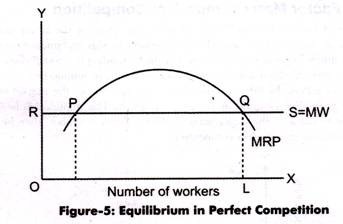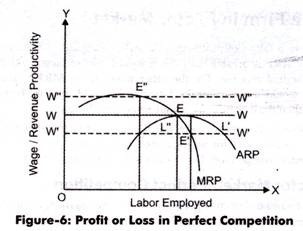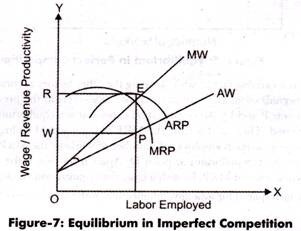Equilibrium of a Firm in Factor Market: Perfect Competition and Imperfect Competition!
When an organization decides to hire a factor of production, it makes comparison between MRP of the factor with that of its Marginal Factor Cost (MFC).
If the MRP is greater than the marginal cost of factor (MRP>MC), then the factor is employed because it would generate more marginal revenue.
On the other hand, when MRP is lesser than the marginal cost of factor (MRP<MC), then the organization would not employ the factor as it would increase costs. In case, the MRP is equal to the marginal cost of factor (MRP=MC), then the organization would attain equilibrium.
ADVERTISEMENTS:
However, in modern times, the organizations determine the actual amount of factors that are required to achieve equilibrium. For determining the equilibrium point, it is necessary for an organization to analyze the factor market in different market structures, such as perfect competition and imperfect competition. Let us discuss the equilibrium of a firm in different market structures.
Equilibrium in Factor Market: Perfect Competition:
In the factor market, under perfect competition, an individual organization cannot affect the prices of a factor of production by increasing or decreasing its consumption.
This is because the quantity demanded by an organization of a particular factor is very small as compared to the market demand. In such a case, the organization cannot affect the price of the factor, thus it has to purchase the factor at the prevailing market price. Even if the organization increases the consumption of the factor, the price of the factor would remain same.
For example, in perfect competition, organizations need to pay wages to its employees according to the wage rates prevailing in the market. Similarly, if we look upon the supply side, a single supplier does not have ample amount of products to meet the demand of all the customers in the market. Therefore, in perfect competition, marginal product (MP) and average product (AP) are same and their curves would intersect each other. Thus, MP and AP would form a straight horizontal line. Here, we would again take the example of labor and wages to understand equilibrium in factor market under perfect competition.
ADVERTISEMENTS:
Figure-5 shows the equilibrium in the factor market under perfect competition:
In Figure-5, we have assumed labor as a variable factor, while keeping the other factors at constant. The RS line shows the marginal wage rate. In the factor market, all organizations can hire any number of workers at the prevailing price OR. The MRP curve of labor intersects the line RS at two points P and Q.
An organization cannot attain equilibrium at point P because at this point the number of workers employed is increased. Thus, in this case, the MRP of labor would be higher than the marginal wage OR. On the other hand, at point Q, when the organization employs OL number of workers, the MRP of labor is equal to its marginal cost.
ADVERTISEMENTS:
Therefore, the organization would attain its equilibrium at point Q. Apart from this, if the organization employs more than OL workers, the marginal cost of labor would exceed MRP. In such a case, the organization would incur losses.
In summation, there are two conditions required for attaining equilibrium in the factor market under perfect competition, which are as follows:
i. MRP = MFC
ii. MRP curve intersects marginal cost from above (as shown in Figure-5)
However, from Figure-5, we cannot determine whether the organization would earn profit or incur loss.
This can be determined with the help of Figure-6:
In Figure-6, MRP intersects Average Revenue Productivity (ARP) at point E. When the wages are at level OW the equilibrium point is attained at E’. On the other hand, when the wages are at level OW”, equilibrium point is achieved at point E”. At point E’, extra profit is E’L’, which is in the short run only.
In the long run, supernormal profit attracts new organizations to enter the market. This increases the demand for labor; therefore, the wage level of labor also increases and reaches OW. At OW wage level, the equilibrium shifts to E and supernormal profit disappears. This is because wages are equal to average revenue productivity.
ADVERTISEMENTS:
However, at equilibrium point E”, the wages are more than the average revenue productivity. In such a case, the organization would incur losses. In case of losses, many organizations would leave the market, which would result in the reduction of labor and wage rates. This again brought the wage level at OW and equilibrium point at E. At this point, MRP would become equal to ARP.
Equilibrium in Factor Market: Imperfect Competition:
In the above, we have discussed the equilibrium of an organization in the factor market under perfect competition. However, in the real world, the factor market is imperfect. Therefore, we would learn the equilibrium of an organization in the factor market under imperfect competition.
For understanding the equilibrium in case of imperfect competition, we would take the case of monopsony. In monopsony, there is only one buyer of factors of production and a large number of sellers. In this case, there is no competitor in the market who wants to buy the factors of production.
ADVERTISEMENTS:
Therefore, the single buyer has a control on the price of factors. This implies that he/she can bargain for the prices of factors as per his/her choice. For example, if the buyer wants to hire a factor say labor, then he/she can set wages according to him/her.
Figure-7 shows the equilibrium in imperfect competition:
In Figure-7, Average Wage (AW) curve moves from left to right in upward direction and Marginal Wage (MW) curve is above the AW curve. In imperfect competition, equilibrium can be attained when MW is equal to MRP. In present case, equilibrium is at point E.
ADVERTISEMENTS:
At point E, AW is NP and MRP is EN and NP is less than EN. This shows that services provided by labor is more than wages provided by the organization to them. In other words, the labor is exploited by the organization. This is also termed as monopolistic exploitation.
In imperfect competition, as the buyer has the power to decide the wages of labor; therefore, labor is exploited in this type of market structure. For example, in case of oligopoly or monopoly, the number of job opportunities is limited and the unemployment is high. In such cases, the labor is ready to work even at low wage rates.


